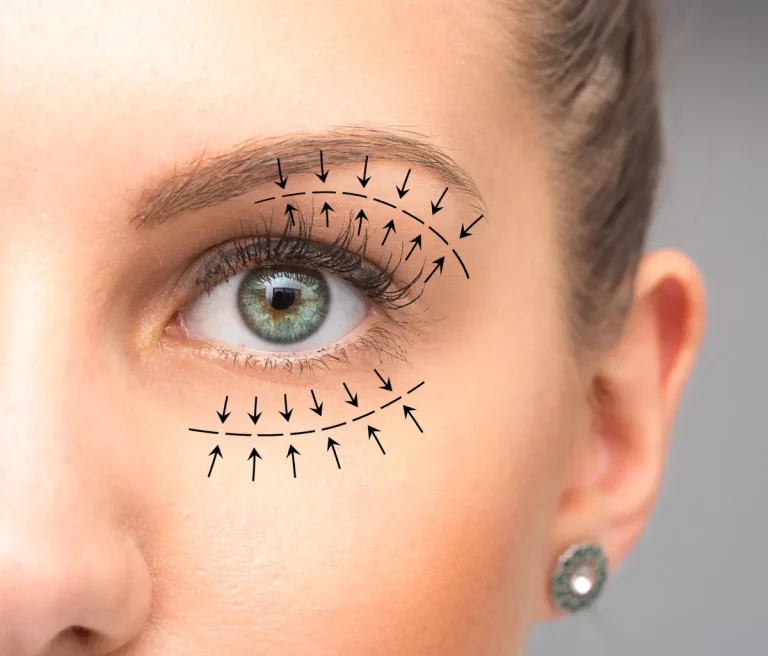بلفاروپلاستی یا جراحی پلک یکی از محبوبترین روشهای زیبایی و درمانی است که به اصلاح ظاهر پلکهای بالا و پایین کمک میکند. این عمل نهتنها چهره شما را زیباتر میکند، بلکه در برخی موارد میتواند مشکلات بینایی ناشی از افتادگی پلک را نیز برطرف کند.
از روشهای انجام تا هزینهها، نتایج مورد انتظار، مراقبتهای لازم و معرفی دکتر بیتا ساقی، در این صفحه ارائه شده است. با ما همراه باشید تا اطلاعات کاملی درباره این جراحی به دست آورید و تصمیم آگاهانهای بگیرید.
برای دریافت مشاوره تخصصی رایگان فرم زیر را تکمیل نمایید در صورتی که به مشاوره تخصصی رایگان در زمینه بلفاروپلاستی نیاز دارید، میتوانید فرم زیر را تکمیل نمایید تا همکاران ما در اسرع وقت با شما تماس حاصل نمایند.

برای درخواست مشاوره رایگان فرم زیر را تکمیل کنید
پلک بالا
جراحی پلک بالا به دو روش اصلی انجام میشود:
- بلفاروپلاستی کلاسیک: در این روش، جراح با ایجاد برش در خط طبیعی پلک، پوست و چربی اضافی را برمیدارد. این تکنیک برای افرادی مناسب است که از افتادگی قابل توجه پلک رنج میبرند.
- بلفاروپلاستی ترانسکونژنکتیوال: در این روش پیشرفته، برش از داخل پلک ایجاد میشود و تنها چربیهای اضافه برداشته میشوند. این تکنیک برای افرادی مناسب است که فقط تجمع چربی دارند و پوست اضافی ندارند.
پلک پایین
جراحی پلک پایین نیز با دو تکنیک اصلی انجام میشود:
- روش ترانسکونژنکتیوال: در این روش، برش در سطح داخلی پلک ایجاد میشود و به چربیهای اوربیتال دسترسی پیدا میشود. این تکنیک برای افرادی مناسب است که تنها پف زیر چشم دارند.
- روش پوستمحور: در این تکنیک، برشی در حدود ۱-۲ میلیمتر زیر خط مژهها ایجاد میشود. این روش برای افرادی مناسب است که علاوه بر پف، چین و چروک و پوست اضافی نیز دارند.
جراحی همزمان پلک بالا و پایین
در مواردی که بیمار نیاز به اصلاح هر دو پلک دارد، جراحی همزمان پلک بالا و پایین انجام میشود. این روش مزایای متعددی دارد:
- صرفهجویی در زمان و هزینه
- نیاز به تنها یک دوره بیهوشی
- بهبودی همزمان هر دو ناحیه
زیبایی و شادابی چشمان شما، با بلفاروپلاستی حرفهای
چشمها اولین چیزی هستند که توجه دیگران را جلب میکنند. با گذشت زمان، افتادگی پلکها و پف زیر چشم میتواند چهره را خسته یا پیرتر از سن واقعی نشان دهد.
بلفاروپلاستی یا جراحی زیبایی پلک راهحلی مؤثر برای بازگرداندن طراوت و جذابیت به چشمان شماست. در کلینیک ما، این جراحی توسط پزشکان مجرب، با رعایت بالاترین استانداردهای ایمنی انجام میشود.
مزایای جراحی بلفاروپلاستی
✅ بهبود میدان دید
✅ چهرهای جوانتر و شادابتر
✅ افزایش اعتماد به نفس
✅ نتایج طبیعی و ماندگار
✅ انجام جراحی با تکنیکهای نوین و حداقل برش
کاندیدای مناسب بلفاروپلاستی چه کسانی هستند؟
افرادی که پوست اضافی یا افتادگی پلک دارند.
کسانی که از پف و تورم زیر چشم رنج میبرند.
افرادی که از سلامت عمومی خوبی برخوردارند و انتظار واقعبینانهای از نتایج دارند.
کسانی که به دنبال بهبود زیبایی چهره یا میدان دید خود هستند.
مراقبتهای بعد از جراحی بلفاروپلاستی
استفاده از کمپرس سرد برای کاهش تورم و کبودی
مصرف دقیق داروهای تجویز شده توسط پزشک
اجتناب از فعالیتهای سنگین و ورزشهای پرفشار
محافظت از پلکها با عینک آفتابی در برابر نور خورشید
رعایت نکات بهداشتی برای جلوگیری از عفونت
نکته تخصصی:
دنبال کردن توصیههای پزشک پس از جراحی، کلید دستیابی به بهترین نتایج ممکن است.
هزینه بلفاروپلاستی در سال ۱۴۰۴
با توجه به تغییرات نرخ خدمات پزشکی در سال ۱۴۰۴، هزینه بلفاروپلاستی به طور متوسط بین ۲۰ تا ۴۰ میلیون تومان متغیر است. عوامل مؤثر در تعیین هزینه عبارتند از:
میزان افتادگی یا پف پلکها
انجام جراحی پلک بالا، پایین یا هر دو
نیاز به بیهوشی یا بیحسی موضعی
تخصص و تجربه جراح
مشاوره تخصصی رایگان:
برای دریافت برآورد دقیق هزینه و مشاوره اولیه، میتوانید همین امروز وقت ملاقات خود را رزرو کنید.
تفاوتها و کاربردها
- بلفاروپلاستی سنتی: دقت بالا در اصلاحات گسترده، مناسب برای موارد پیچیدهتر.
- بلفاروپلاستی با لیزر: دوره نقاهت کوتاهتر، مناسب برای افرادی با مشکلات خفیفتر.
انتخاب روش مناسب به شرایط شما و نظر متخصص بستگی دارد. برای اطلاعات بیشتر درباره جزئیات این روشها، میتوانید با کلینیک تماس بگیرید یا با دکتر بلفاروپلاستی در تهران مشورت کنید.
عوارض احتمالی بلفاروپلاستی
هرچند بلفاروپلاستی جزو جراحیهای ایمن و کمریسک است، اما احتمال بروز برخی عوارض وجود دارد:
تورم و کبودی موقت
خشکی چشم یا حساسیت به نور
عدم تقارن جزئی در پلکها
خونریزی یا عفونت نادر
جای زخم (معمولاً به صورت بسیار محو و قابلپوشش)
اطمینان خاطر:
با انتخاب پزشک باتجربه و رعایت کامل نکات مراقبتی، میتوان احتمال این عوارض را به حداقل رساند.
- متخصص پوست، مو، لیزر و زیبایی
- عضو انجمن متخصصین پوست ایران و اروپا
- مدرس کارگاه های آموزشی برای متخصصین پوست
- انجام کلیه خدمات درمانی و زیبایی مطابق به روزترین متد روز دنیا
نتایج مورد انتظار از بلفاروپلاستی
نتایج جراحی بلفاروپلاستی معمولاً پس از چند هفته قابل مشاهده است، اما بهبودی کامل ممکن است چند ماه طول بکشد. در زیر زمانبندی بهبودی را بررسی میکنیم:
- کوتاهمدت (2 تا 4 هفته): کاهش تورم و کبودی، ظاهر اولیه پلکها مشخص میشود.
- بلندمدت (تا 6 ماه): پلکها کاملاً طبیعی و جوانتر به نظر میرسند.
بسیاری از بیماران گزارش میدهند که پس از جراحی، نهتنها ظاهر بهتری پیدا کردهاند، بلکه اعتماد به نفس بیشتری نیز دارند. برای مشاهده تصاویر قبل و بعد، میتوانید به گالری تصاویر کلینیک مراجعه کنید.

تغییرات قابل مشاهده پس از بلفاروپلاستی
چهرهای شادابتر و جوانتر
بسیاری از بیماران پس از بلفاروپلاستی از تغییرات مثبت در چهره خود صحبت کردهاند. افتادگی پلکها و پف زیر چشم که باعث میشد چهره خسته یا غمگین به نظر برسد، بهطور کامل رفع شده و چهرهای شادابتر ایجاد شده است.
- بهبود اعتماد به نفس
- بهبود میدان دید
ماندگاری بلفاروپلاستی
ماندگاری بلفاروپلاستی (جراحی زیبایی پلک) معمولاً بین ۷ تا ۱۰ سال است، و در بسیاری از موارد، اثرات آن برای همیشه باقی میماند، بهویژه اگر سبک زندگی سالم و مراقبتهای پوستی رعایت شود.
| عامل مؤثر | توضیح |
|---|---|
| سن هنگام جراحی | در سنین پایینتر (۴۰ تا ۵۰ سال)، نتایج ماندگاری بیشتری دارد. |
| نوع پوست و ژنتیک | پوستهای نازکتر یا مستعد افتادگی ممکن است زودتر تغییر کنند. |
| عادات سبک زندگی | مصرف دخانیات، استرس، بیخوابی و آفتاب زیاد، سرعت پیری را بالا میبرند. |
| مراقبت پس از جراحی | رعایت مراقبتهای بعد از عمل، استفاده از کرم ضدآفتاب و پرهیز از فشار به پلک مهم است. |
| تکنیک جراحی و مهارت جراح | جراحی دقیق و صحیح توسط پزشک متخصص، تضمینکننده ماندگاری بهتر است. |
مراقبتهای قبل و بعد از جراحی پلک
برای موفقیت در بلفاروپلاستی، رعایت مراقبتهای قبل و بعد از جراحی ضروری است. در ادامه نکات کلیدی را مرور میکنیم:
مراقبتهای قبل از جراحی
- حداقل دو هفته قبل از عمل سیگار نکشید.
- از مصرف داروهای رقیقکننده خون (مثل آسپرین) خودداری کنید.
- آزمایشهای لازم را طبق دستور جراح انجام دهید.
مراقبتهای بعد از جراحی
- از کمپرس سرد برای کاهش تورم استفاده کنید.
- داروهای تجویز شده را به موقع مصرف کنید.
- تا چند هفته از فعالیتهای سنگین یا ورزش شدید پرهیز کنید.
رعایت این نکات به شما کمک میکند تا دوره نقاهت کوتاهتر و نتایج بهتری داشته باشید.
معرفی متخصص: دکتر بیتا ساقی
دکتر بیتا ساقی یکی از برجستهترین متخصصان جراحی پلک در تهران است. ایشان با سالها تجربه در زمینه جراحیهای زیبایی و درمانی، توانستهاند رضایت صدها بیمار را جلب کنند.
بیوگرافی کوتاه
- مبتکر روش نوین عمل بلفاروپلاستی (جراحی پلک)
- مؤلف کتاب مروری بر پمفیگوس
- مدرس کارگاه های آموزشی برای متخصصین پوست کشور
- مترجم کتب مرجع متخصصین پوست – رابینسون – ۲۰۲۱
- مترجم کتب مرجع آزمون ارتقا متخصصین پوست – بولونیا – ۲۰۲۰

خلاصه ای از بلفاروپلاستی
| عنوان | جزئیات |
|---|---|
| تعریف بلفاروپلاستی | جراحی پلک برای بهبود ظاهر و عملکرد پلکها؛ رفع افتادگی، پف زیر چشم و چربی اضافی. |
| اهداف جراحی | – اهداف زیبایی: جوانتر و شادابتر نشان دادن چهره. – اهداف درمانی: بهبود دید محیطی و رفع مشکلات عملکردی. |
| مدت زمان جراحی | ۱ تا ۲ ساعت برای یک یا هر دو پلک؛ بسته به پیچیدگی جراحی. |
| سن مناسب برای جراحی | افراد بالای ۱۸ سال؛ جوانان برای مشکلات ژنتیکی و افراد مسنتر برای رفع علائم پیری. |
| فواید جراحی | – بهبود ظاهر و افزایش اعتمادبهنفس. – رفع پف زیر چشم. – بهبود عملکرد بینایی. |
| عوارض شایع | – تورم و کبودی. – خشکی یا تحریک چشم. – حساسیت به نور یا تاری دید موقتی. |
| عوارض نادر | – عفونت یا خونریزی. – عدم تقارن پلکها. – مشکلات عملکردی پلک مانند بستن کامل چشمها. |
| نوع بیحسی/بیهوشی | بیحسی موضعی یا بیهوشی عمومی؛ بسته به شرایط بیمار و پیچیدگی جراحی. |
| مراقبتهای قبل از جراحی | – انجام مشاوره و آزمایشهای لازم. – پرهیز از داروهای رقیقکننده خون و دخانیات. |
| دوره نقاهت | – ۷ تا ۱۰ روز برای بازگشت به فعالیتهای روزمره. – بهبود کامل طی ۲ تا ۳ ماه. |
| هزینه جراحی | لطفاً با کلینیک تماس بگیرید. 02179527 |
| خدمات کلینیک دکتر بیتا ساقی | جراحی پلک، لیفت ابرو، لیفتینگ صورت با نخ، بوکال فت، لیفت سانترال لب، کاشت مو، و ساکشن غبغب. |
برای درخواست مشاوره رایگان فرم زیر را تکمیل کنید
چرا کلینیک ما را برای بلفاروپلاستی انتخاب کنید؟
- استفاده از بهروزترین تکنیکهای جراحی پلک
- مشاوره تخصصی پیش از عمل
- پیگیری دقیق وضعیت بیمار پس از جراحی
- محیطی ایمن و مجهز
مشاوره رایگان بگیرید!
برای دریافت مشاوره تخصصی درباره بلفاروپلاستی، تخمین هزینه، و بررسی وضعیت شما، همین امروز با ما تماس بگیرید.
زیبایی طبیعی چشمهای شما، تخصص ماست.
📞 شماره تماس: 02179527
📍 آدرس کلینیک: تهران، پاسداران، بوستان نهم، پلاک 117، طبقه 5 واحد 14
📅 همین حالا نوبت مشاوره خود را رزرو کنید!
برای مشاهده سایر خدمات مربوط به جوانسازی و زیبایی صورت به صفحه ” جراحی زیبایی صورت” مراجعه نمایید.
سوالات متداول
عمل بلفاروپلاستی معمولاً بین 30 تا 120 دقیقه طول میکشد، بسته به اینکه فقط پلک بالا یا پایین جراحی شود یا هر دو.
نتایج بلفاروپلاستی، بهویژه برای کیسههای چربی پلک، تقریباً دائمی است. با این حال، روند طبیعی پیری ادامه خواهد داشت و ممکن است پس از چند سال نیاز به اصلاحات جزئی وجود داشته باشد.
نتایج اولیه عمل معمولاً پس از 2 تا 4 هفته قابل مشاهده است، اما نتیجه نهایی پس از 3 تا 6 ماه مشخص میشود.
اگر افتادگی پلک باعث اختلال در بینایی شود، بیمه تکمیلی و تامین اجتماعی ممکن است بخشی از هزینهها را پوشش دهند. اما اگر هدف از جراحی صرفاً زیبایی باشد، معمولاً تحت پوشش بیمه قرار نمیگیرد.
دوره بهبودی اولیه معمولاً 1 تا 2 هفته طول میکشد. تورم و کبودی به تدریج کاهش مییابد و اکثر بیماران میتوانند پس از 2 هفته به فعالیتهای عادی خود بازگردند. بهبودی کامل ممکن است تا چند ماه طول بکشد.


